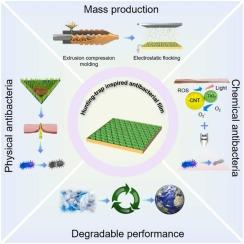高效制备具有增强抗菌活性和减少污染物传播的狩猎陷阱启发可降解薄膜
IF 11.3
1区 环境科学与生态学
Q1 ENGINEERING, ENVIRONMENTAL
引用次数: 0
摘要
医用防护聚合物的广泛应用为保护人类生命和福祉作出了重大贡献。由于保护性高分子材料的广泛使用及其不可降解性,环境和生物污染问题日益严重。为了解决传统高分子材料造成的环境污染问题,本研究提出了一种高效、连续的方法,通过微挤压压缩成型和静电植绒相结合,大规模生产具有狩猎陷阱启发的金字塔微/纳米结构的聚乳酸/氧化石墨烯(MNPG)薄膜。受狩猎陷阱启发的金字塔微/纳米结构增强了液体驱避和抗菌性能,有效减少污染物粘附。MNPG薄膜显示出令人印象深刻的抗菌效果,抑制细菌生长高达98.1%,对常见液体(如血液,牛血清白蛋白,牛奶和茶)表现出优异的驱蚊性,没有可检测到的残留物。这提供了最初的保护,防止细菌的粘附和传播,以及污染物的传播。重要的是,在降解实验中,该膜在14天后仅保留了原始质量的30%,表明了良好的生物降解性。这种方法为设计可持续保护材料提供了一种新方法,并具有取代传统不可降解聚合物的潜力。本文章由计算机程序翻译,如有差异,请以英文原文为准。

Efficient fabrication of hunting trap inspired degradable film with enhancing antimicrobial activity and reducing fomite transmission
The extensive application of medical protective polymers has significantly contributed to preserving human lives and well-being. Due to the widespread use of protective polymer materials and their non-degradable nature, environmental and biological pollution issues are becoming increasingly severe. To address the environmental pollution problems caused by traditional polymer materials, this study proposes an efficient and successive method for the mass production of polylactic acid/graphene oxide (MNPG) films with the hunting trap-inspired pyramidal micro/nanostructure by combining micro-extrusion compression molding and electrostatic flocking. The hunting trap-inspired pyramidal micro/nanostructure enhances liquid repellency and antibacterial performance, effectively reducing contaminant adhesion. The MNPG film exhibits an impressive antibacterial efficacy, inhibiting bacterial growth by up to 98.1%, demonstrating excellent repellency against common liquids, such as blood, bovine serum albumin, milk, and tea, leaving no detectable residue. This provides initial protection against bacterial adhesion and dissemination as well as the spread of pollutants. Importantly, the film retains only 30 wt% of its original mass after 14 days in degradation experiments, indicating favorable biodegradability. This method offers a novel approach for designing sustainable protective materials and holds potential to replace traditional non-degradable polymers.
求助全文
通过发布文献求助,成功后即可免费获取论文全文。
去求助
来源期刊

Journal of Hazardous Materials
工程技术-工程:环境
CiteScore
25.40
自引率
5.90%
发文量
3059
审稿时长
58 days
期刊介绍:
The Journal of Hazardous Materials serves as a global platform for promoting cutting-edge research in the field of Environmental Science and Engineering. Our publication features a wide range of articles, including full-length research papers, review articles, and perspectives, with the aim of enhancing our understanding of the dangers and risks associated with various materials concerning public health and the environment. It is important to note that the term "environmental contaminants" refers specifically to substances that pose hazardous effects through contamination, while excluding those that do not have such impacts on the environment or human health. Moreover, we emphasize the distinction between wastes and hazardous materials in order to provide further clarity on the scope of the journal. We have a keen interest in exploring specific compounds and microbial agents that have adverse effects on the environment.
 求助内容:
求助内容: 应助结果提醒方式:
应助结果提醒方式:


